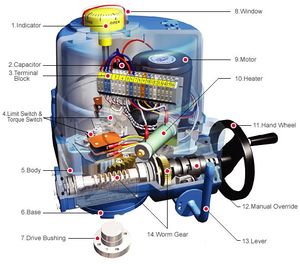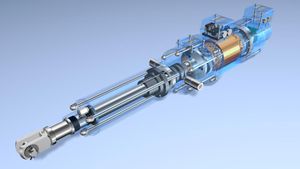Difference between revisions of "Electrical Actuators"
(Created page with "Category:Actuators, Drives{{Knoppen}} <noinclude><!------------------------------------------------ * READ THIS FIRST * Only edit this page if you can improve the content. *...") |
|||
| Line 7: | Line 7: | ||
* Please start editing this page after the /noinclude | * Please start editing this page after the /noinclude | ||
* -------------------------------------------------></noinclude> | * -------------------------------------------------></noinclude> | ||
[[File:Electric actuator.jpg|thumb|right|Electrical Actuators]] | |||
[[File:Electric actuator1.jpg|thumb|right|Electrical Actuators]] | |||
'''Electrical Actuator''' is an electromechanical device that converts electrical energy into mechanical energy.Most electric actuators operate through the interaction of magnetic fields and current-carrying conductors to generate force. The reverse process, producing electrical energy from mechanical energy, is done by generators such as an alternator or a dynamo; some electric actuators can also be used as generators, for example, a traction motor on a vehicle may perform both tasks. Electric actuators and generators are commonly referred to as electric machines. | |||
==Applications== | |||
Electric actuators are found in applications as diverse as industrial fans, blowers and pumps, machine tools, household appliances, power tools, and disk drives. They may be powered by direct current, e.g., a battery powered portable device or motor vehicle, or by alternating current from a central electrical distribution grid or inverter. Small actuators may be found in electric wristwatches. Medium-size motors of highly standardized dimensions and characteristics provide convenient mechanical power for industrial uses. The very largest electric actuators are used for propulsion of ships, pipeline compressors, and water pumps with ratings in the millions of watts. Electric actuators may be classified by the source of electric power, by their internal construction, by their application, or by the type of motion they give. | |||
==Sources== | |||
[http://en.wikipedia.org/wiki/Electric_motor Wikipedia Electrical Actuators] | |||
Latest revision as of 10:46, 6 December 2012
Electrical Actuator is an electromechanical device that converts electrical energy into mechanical energy.Most electric actuators operate through the interaction of magnetic fields and current-carrying conductors to generate force. The reverse process, producing electrical energy from mechanical energy, is done by generators such as an alternator or a dynamo; some electric actuators can also be used as generators, for example, a traction motor on a vehicle may perform both tasks. Electric actuators and generators are commonly referred to as electric machines.
Applications
Electric actuators are found in applications as diverse as industrial fans, blowers and pumps, machine tools, household appliances, power tools, and disk drives. They may be powered by direct current, e.g., a battery powered portable device or motor vehicle, or by alternating current from a central electrical distribution grid or inverter. Small actuators may be found in electric wristwatches. Medium-size motors of highly standardized dimensions and characteristics provide convenient mechanical power for industrial uses. The very largest electric actuators are used for propulsion of ships, pipeline compressors, and water pumps with ratings in the millions of watts. Electric actuators may be classified by the source of electric power, by their internal construction, by their application, or by the type of motion they give.

